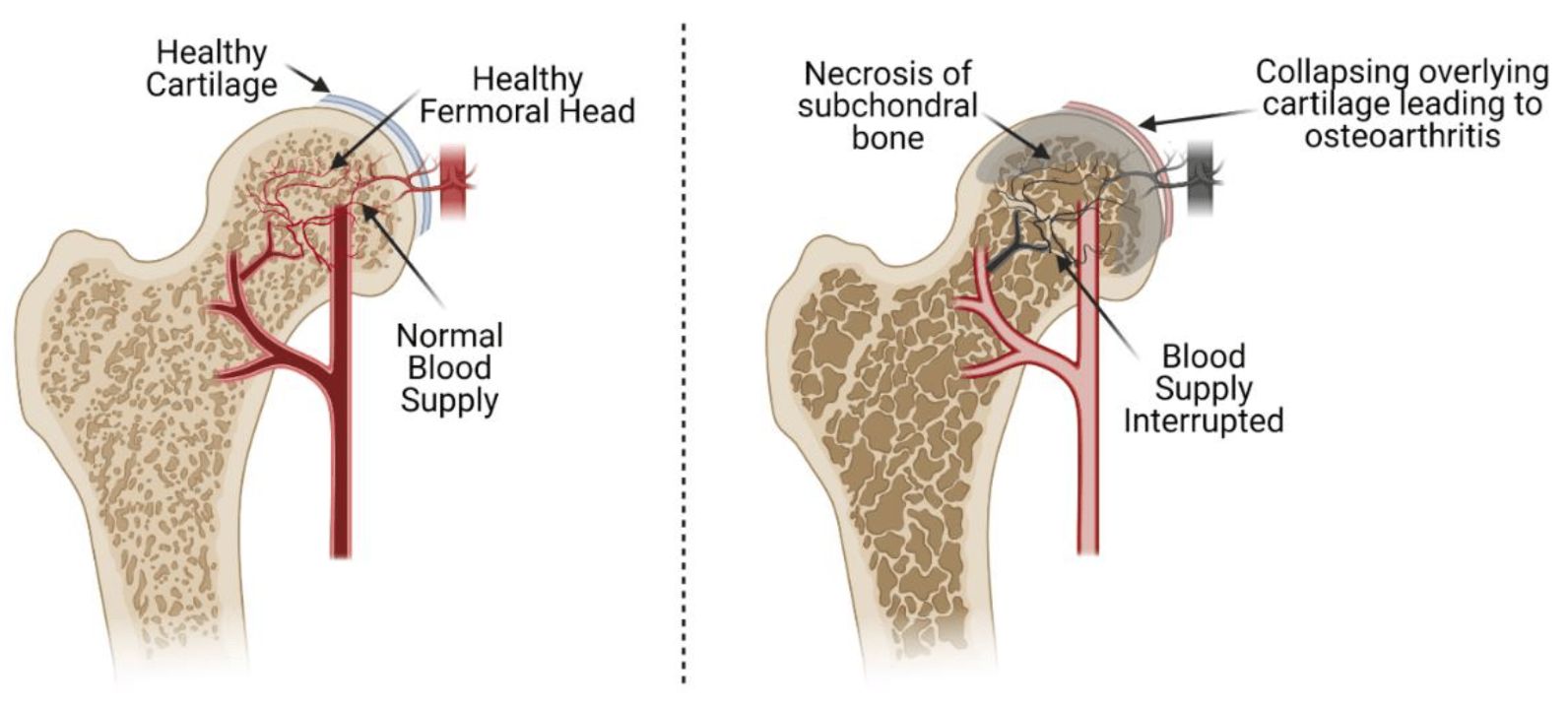Are you experiencing hip pain and difficulty walking? You may be suffering from avascular necrosis of the femoral head. This condition happens when the blood supply to the bone in your hip joint is disturbed, leading to bone death and eventual collapse. Causes of avascular necrosis could include trauma, long-term steroid use, excessive alcohol consumption, and certain medical conditions.
If not addressed, avascular necrosis can significantly lower your quality of life. However, early diagnosis and treatment can help avoid further damage and relieve your symptoms. Diagnostic tests such as X-rays and MRI scans can determine the condition’s intensity, while medications and surgical interventions may be recommended for more serious cases.
Hip arthritis, caused by the joint’s cartilage wearing away, is one common cause. This can bring on pain, stiffness, and reduced mobility in the hip.
Not having enough blood flowing to the femoral head can be caused by trauma or certain medical conditions. Without the right amount of blood, the bone tissue in the femoral head starts to deteriorate, resulting in avascular necrosis.
It’s important to notice the symptoms of hip arthritis, such as pain and swelling, and to find the right treatment options, like physical therapy or medication, to stop further damage and the potential for avascular necrosis.
Excessive alcohol consumption, smoking, and high-dose corticosteroid use are all associated with an increased risk of developing avascular necrosis in the hip joint. These factors can negatively affect blood flow to the femoral head, resulting in its deterioration.
Alcohol consumption can disrupt bone metabolism and impede blood supply, increasing the risk of avascular necrosis. Smoking has been linked to reduced blood flow and oxygen delivery to the bones, which can lead to tissue damage in the hip area. High-dose corticosteroids, which are typically used to treat conditions such as asthma or autoimmune disorders, can also inhibit blood supply by causing osteoporosis and weakening bone structure.
Avoiding these risk factors can help reduce the chances of avascular necrosis and potentially prevent hip arthritis in the future.
If you experience persistent hip pain and difficulty walking, it may be important to recognize the signs and symptoms associated with avascular necrosis of the femoral head. This condition is characterized by the death of bone tissue due to inadequate blood supply.
 Photo Credit: Freepik
Photo Credit: Freepik
A common symptom is hip pain that escalates with activity and may spread to other areas such as the groin or buttocks. You may also feel stiffness in the hip joint, making it hard to move or perform daily activities.
As avascular necrosis progresses, you might experience decreased range of motion and trouble bearing weight on the affected leg. Paying attention to these signs is essential as early intervention can avert further damage and improve outcomes.
If you suspect avascular necrosis, seek medical attention for an accurate diagnosis and appropriate treatment options.
Consider getting diagnostic tests done to accurately identify the cause of your hip pain and determine the best course of treatment. Early diagnosis is essential for effectively managing avascular necrosis of the femoral head.
A hip X-ray is a common diagnostic test used, which can detect any structural abnormalities or changes in the bone. It can also show signs of arthritis in the hip joint, such as joint space narrowing or bone spurs.
MRI may be recommended to provide more detailed information about the extent of damage to the femoral head.
Blood tests may be done to rule out other possible causes of hip pain and confirm a diagnosis of avascular necrosis.
Accurate diagnosis through these tests can provide appropriate and effective treatment options tailored to your needs.
The stages of avascular necrosis of the femoral head can be classified based on the severity of damage to the hip bone. Knowing these stages is important for successful treatment and management of this condition. Here are four crucial stages you should be aware of:
Knowing these stages can help people make informed decisions about their treatment options and enhance their quality of life while seeking relief from hip arthritis pain.
Let’s look at the treatment options available. The aim is to reduce pain, increase function, and maintain the hip joint. Conservative measures are usually recommended in the early stages or for patients who can’t have surgery. This could include medications to reduce pain and inflammation, physical therapy to build up the muscles around it and improve the range of motion, and assistive devices such as crutches or canes.
 Photo Credit: Freepik
Photo Credit: Freepik
Surgical options may be considered in more advanced cases or when conservative measures haven’t been successful. Core decompression involves drilling into the affected area to reduce pressure and encourage new blood vessel formation. Another option is osteotomy, where a surgeon reshapes and repositions the femur to redistribute the weight-bearing forces. For serious cases with considerable damage or hip arthritis, total hip replacement surgery may be necessary.
It’s essential to consult with a healthcare professional specialized in treating avascular necrosis of the femoral head to decide which treatment option is suitable for you, taking into account your circumstances and objectives for relief from pain and restrictions caused by this condition.
If you’re suffering from pain and inflammation in your hip, medications may effectively relieve discomfort and increase your mobility. Regarding avascular necrosis of the femoral head (AVN), medication therapy focuses primarily on managing symptoms and slowing down the condition’s progression.
Nonsteroidal anti-inflammatory drugs (NSAIDs), such as ibuprofen or naproxen, can help reduce pain and inflammation related to AVN. However, these medications do not address the root cause of AVN.
In some cases, corticosteroid injections may be recommended to provide temporary pain and inflammation relief. This is usually done when conservative treatments have not brought any significant improvement.
It is important to remember that medication is not a cure for AVN, but rather a way to manage symptoms while other treatments are evaluated or considered.
Surgical interventions may be a potential solution to hip pain and increase mobility. Core decompression is a regular procedure for treating avascular necrosis of the femoral head. It involves drilling into the necrotic area of the bone to allow new blood vessels to form and stimulate healing.
 Photo Credit: MDPI
Photo Credit: MDPI
Another choice is total hip replacement surgery, wherein the defective femoral head is removed and replaced with an artificial implant. This operation can aid in easing pain and enhancing mobility for those with developed AVN or hip arthritis.
Although medications or hip injections for arthritis may provide temporary relief, surgical interventions are often required for lasting improvement and liberation from painful hip issues.
Rehabilitation and physical therapy can play a crucial role in helping you regain strength, flexibility, and mobility after surgery to reduce hip pain.
Exercises for hip arthritis are an integral part of the rehabilitation process. These activities focus on increasing the range of motion, strengthening muscles around the hip joint, and decreasing discomfort.
Common hip arthritis exercises include gentle stretches such as hip flexor stretches, hamstring stretches, and piriformis stretches. Strengthening exercises such as squats, lunges, and leg lifts can also help improve muscle tone and stability around the hip joint.
 Photo Credit: Healthline
Photo Credit: Healthline
Aquatic therapy or swimming can benefit people with arthritis in the hip as it provides low-impact resistance, which can help build strength without placing too much stress on the joint.
Rehabilitation and physical therapy should be tailored to your individual needs and goals under the guidance of a qualified healthcare professional.
To prevent hip pain and improve your quality of life, make lifestyle changes such as maintaining a healthy weight, staying active, and practising good posture. These simple adjustments can help reduce the risk of developing avascular necrosis of the femoral head or worsening symptoms if you already have it. Here are four key strategies to consider:
By following these preventive measures, you can take control of your hip health and reduce the risk of avascular necrosis of the femoral head or other forms of hip arthritis in the future.
The best treatment for avascular necrosis of the femoral head depends on the severity of the condition. Non-surgical treatments may include medications, physical therapy, and crutches to reduce weight on the affected hip. Surgical options such as core decompression, bone transplant (graft), bone reshaping (osteotomy), or joint replacement may be considered in more severe cases.
The signs of avascular necrosis of the femoral head can include hip, groin, or thigh pain, which may be more noticeable when standing or walking. The pain may develop gradually or come on suddenly and may become worse over time. Some people may also experience stiffness or a limited range of motion in the hip.
The extent of bone damage determines the stage of avascular necrosis of the femoral head and can be classified using the Ficat and Arlet staging system. Stage I is the earliest stage, with no visible changes on X-rays but MRI may show bone changes. Stage II shows visible changes on X-rays. Stage III involves a flattened femoral head. Stage IV is the most severe, with damage extending to the hip socket.
If avascular necrosis of the femoral head is left untreated, it can lead to severe pain and limited mobility. Over time, the bone can collapse, leading to arthritis in the joint. This can significantly impair the function of the hip and may eventually require joint replacement surgery.
Avascular necrosis of the femoral head is diagnosed through physical examination, patient history, and imaging tests. X-rays, MRIs, and bone scans are commonly used to confirm the diagnosis and determine the extent of the condition.
While early-stage avascular necrosis can be managed with non-surgical treatments to slow progression and relieve symptoms, the damage to the bone cannot be reversed. In later stages, surgical intervention is typically required.